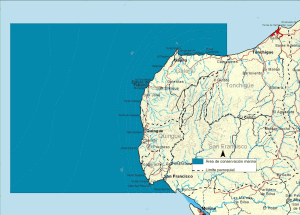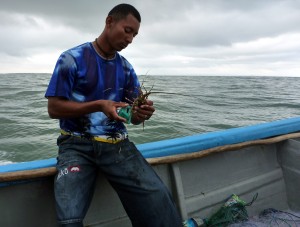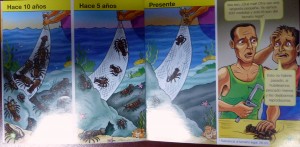 Last week I traveled with colleagues from Conservation International to the small community of San Francisco del Cabo in Esmeraldas Province where Conservation International and Instituto Nazca have been working with local lobster fishermen to help rebuild the degraded fishery and build knowledge of the fishery so that it can be successfully managed in the future. Conservation International is supporting the project through a conservation agreement in which the local lobster fishermen receive monetary payments in exchange for not fishing and for working on monitoring and conservation efforts for the project.
Last week I traveled with colleagues from Conservation International to the small community of San Francisco del Cabo in Esmeraldas Province where Conservation International and Instituto Nazca have been working with local lobster fishermen to help rebuild the degraded fishery and build knowledge of the fishery so that it can be successfully managed in the future. Conservation International is supporting the project through a conservation agreement in which the local lobster fishermen receive monetary payments in exchange for not fishing and for working on monitoring and conservation efforts for the project.
The local fishermen have formed an organization, Arte Longosta, to carry out the conservation actions. This organization is split into four groups which work in monitoring of the biological health of the area; monitoring the fishery; community outreach and education; and enforcement. What impressed me most about the visit was the knowledge and interest that the fishermen showed not only in performing the tasks of the conservation project but in truly understanding the effects of the conservation efforts and how future management efforts would work.
The first morning we went out into the reserve with the fishery monitoring group and the project manager from Nazca and Nazca’s Executive Director. The fishery monitoring group serves two purposes, first, they test new fishing equipment and second they collect data on the lobsters caught and the by-catch. In the past the fishermen have used bottom drag nets which result in massive amounts of by-catch and damage the corals and other life on the sea floor. They are now testing lobster traps which would not only reduce the level of by-catch but also reduce the damage to the sea floor. On our monitoring trip we took in two bottom set gillnets (better than the drag nets but still not ideal) and one trap. The nets proved relatively successful catching about 20 lobsters all below the size limit, and about 30 fish were caught as by-catch. Unfortunately the trap was broken, but the next day after the fishermen had mended the trap they caught two large lobsters so hopefully the traps will prove to be a viable alternative. In addition to testing the effectiveness of the different methods, the fishermen are also marking and recording the size of the lobsters, and recording the size and species of the by-catch.
After getting back to shore we had a marathon meeting with Arte Longosta, hearing from all the fishermen about their work, and the benefits and constraints of the project. Almost all of the fishermen talked about what they had been doing in their groups and what they had learned. I was very impressed with their presentations and the desire they had to understand what they were observing and to educate the rest of the community about the project. Among their outreach efforts is a children’s picture book produced by Nazca that helps explain the need for better management of the sea.
More updates to come when I have the time to write.





